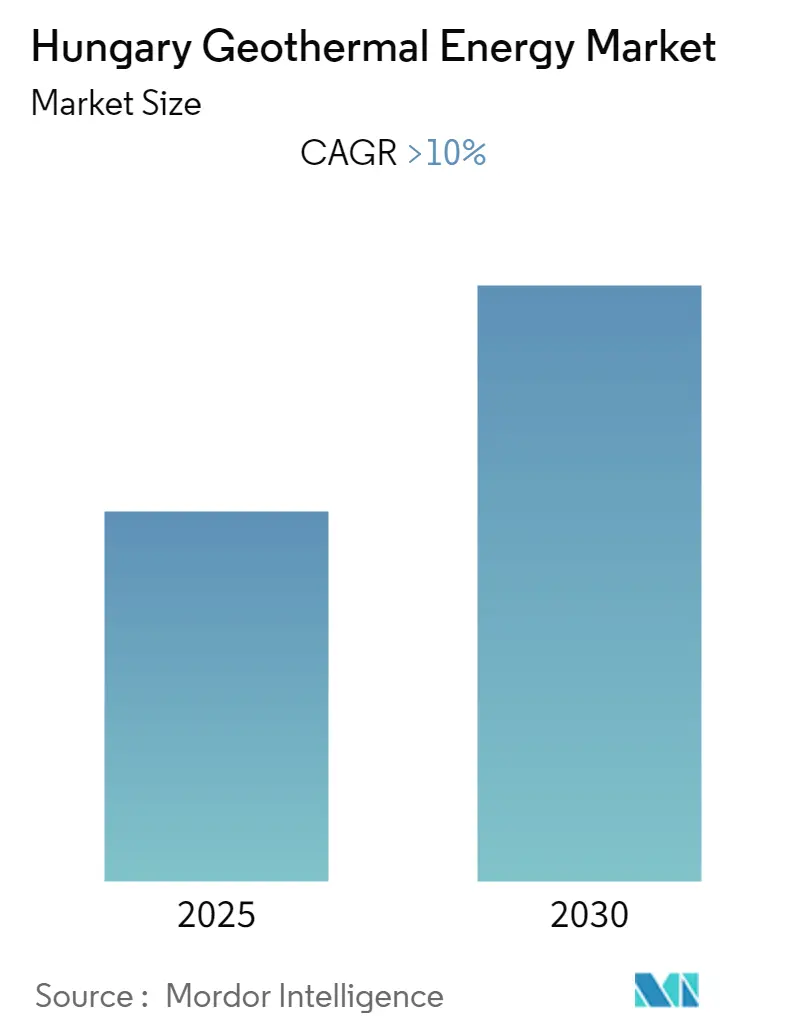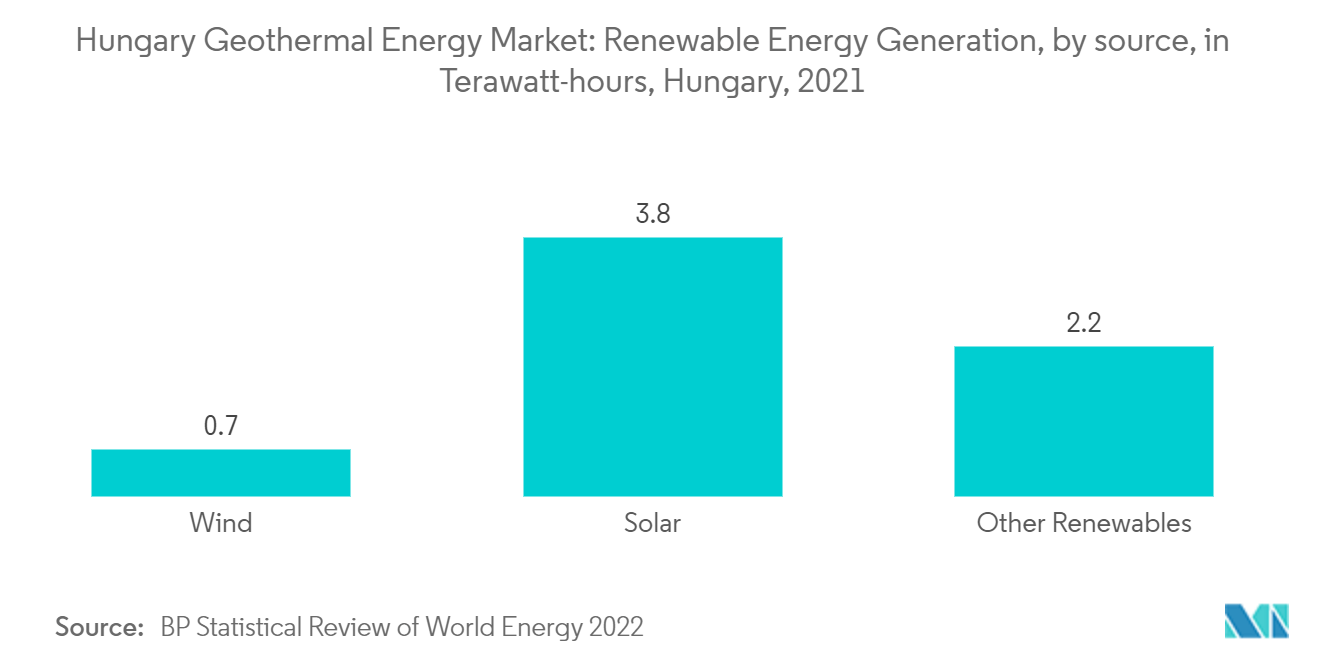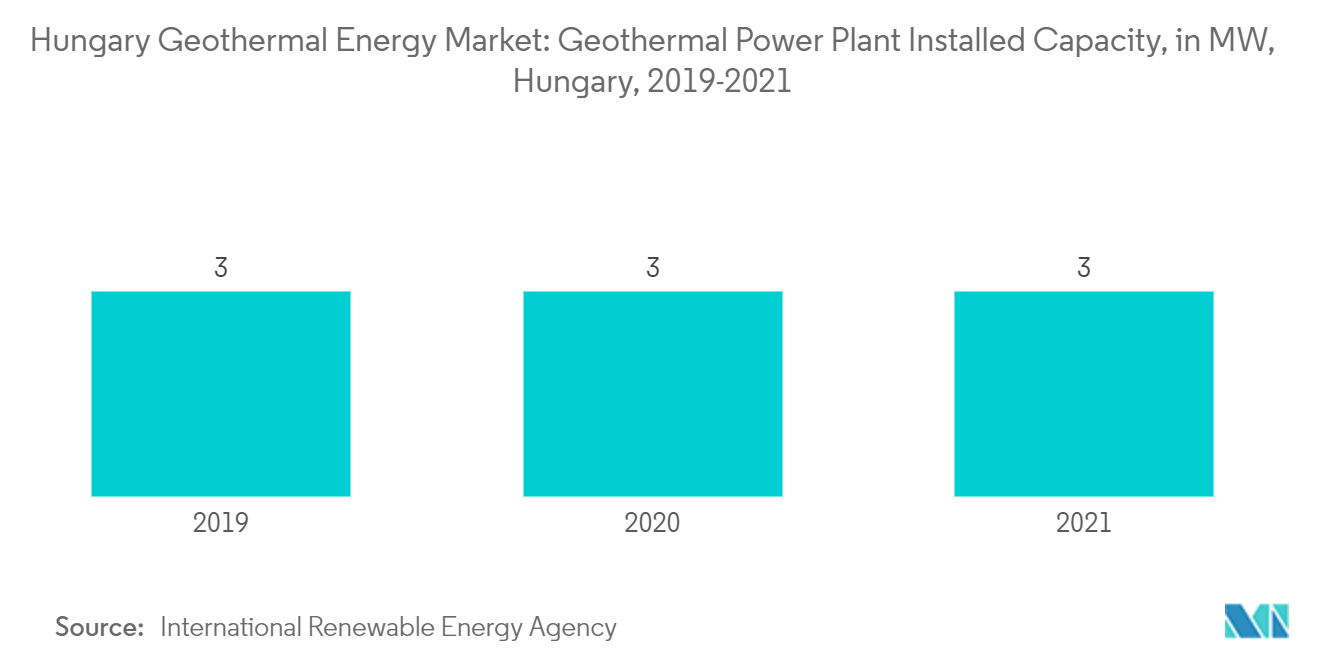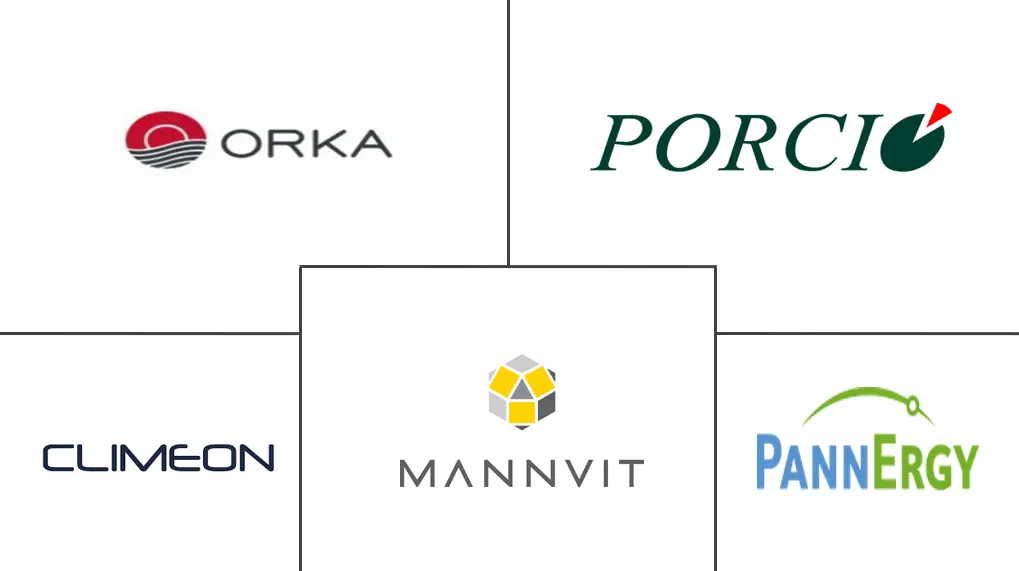
Hungary Geothermal Energy Market Analysis by Mordor Intelligence
The Hungary Geothermal Energy Market is expected to register a CAGR of greater than 10% during the forecast period.
The market was negatively impacted by COVID-19 in 2020. Presently, the market has reached pre-pandemic levels.
- Over the medium term, factors such as government initiatives to reduce the dependency on energy imports from foreign nations are likely to drive the market during the forecast period.
- On the other hand, the lucrative market for alternative clean energy sources like solar and wind are expected to hinder the market's growth during the forecast period.
- Nevertheless, the Hungarian government announced plans to support the upscale of domestic geothermal energy, which are likely to create lucrative growth opportunities for the Hungary geothermal energy market during the forecast period.
Hungary Geothermal Energy Market Trends and Insights
Increasing Demand for Alternative Clean Energy Sources Expected to Hinder the Market
- Hungary has increased its climate ambitions by legislating a carbon neutrality goal for 2050 and adopting a long-term vision with the National Clean Development Strategy, which guides energy policy decision-making. Hungary has a strong starting point with multiple low-carbon generations, and the government has an ambitious target of 90% clean electricity by 2030.
- In 2021, Hungary sourced most of its electricity from solar energy. In 2021, 3.8 terawatt hours were derived from this source, while other renewables and wind energy sources ranked second and third, respectively.
- According to preliminary statistics by the Hungarian Energy and Public Utility Regulatory Authority (MEKH), Hungary's renewables accounted for 19.2% of Hungary's electricity generation in 2021.
- In 2021, solar was the leading renewable power generating source with 3,793-gigawatt hours (GWh), a Y-o-Y increase of 54.3%. It reached a 10.6% share in Hungary's power generation and 55.2% in its combined renewable power output. Biomass and wind contributed 25.9% and 9.5% of renewable generation, respectively.
- In May 2022, Hungary's state-owned MVM Group's renewables announced plans to build 28 new solar power plants with 0.5 MW capacity each. The EUR 17.3 million investment is partly supported by EU funds. The new plants are expected to start commercial operation next year. The project complies with MVM's mid-term strategy, which aims to accelerate the uptake of renewable energy sources in Hungary in line with the 2050 climate goals and the country's green transition.
- Thus, the existing, upcoming, and planned alternative clean energy projects such as solar, wind, and others are expected to hinder the market's growth during the forecast period.

Geothermal Power Generation to Dominate the Market
- Geological exploration, wells drilled for thermal water management (more than 85% of the nation's drinking water is supplied by deep wells), and wells drilled for hydrocarbon resources have all been used to identify Hungary's geothermal potential.
- Iran's geothermal power plant installed capacity has remained the same for the past few years. In 2021, the geothermal power plant installed capacity was 3 MW.
- Under the concessional system (obligatory for exploring and exploiting geothermal energy at a depth below 2,500 m, the typical depth range for power production and CHP projects), a preliminary complex vulnerability and impact assessment (CVIA) has been prepared for over 20 potential geothermal areas.
- In September 2022, Gergely Gulyas, the chief of staff to Prime Minister Viktor Orban, announced that Hungary plans to reduce gas use by 25% in the current heating season at public institutions and businesses, except for hospitals and social institutions, due to rising energy costs.
- The country's government is highly focused on the power generation facility through its geothermal energy, and it is expected to reduce its dependency on natural gas for heat and electricity generation.
- The country is estimated to increase its power generation capacity to around 12 MWe by 2025, with electricity production of about 36,000 GWhe/year.
- The rising capacity is estimated to increase the geothermal share in the country's total electricity production.

Competitive Landscape
The Hungarian geothermal energy market is consolidated in nature. Some of the major players in the market (in no particular order) include Mannvit, PannErgy PLC, KS Orka Renewables Pte Ltd, Porcio Co. Ltd, and Climeon AB.
Hungary Geothermal Energy Industry Leaders
-
Mannvit
-
Climeon AB
-
PannErgy PLC
-
KS Orka Renewables Pte Ltd
-
Porcio Co. Ltd.
- *Disclaimer: Major Players sorted in no particular order

Recent Industry Developments
- In October 2022, the Hungarian government announced plans to support the upscale of domestic geothermal energy, which can reduce the country's energy dependence by replacing about 1-1.5 billion cubic meters (bcm) of natural gas annually.
- In August 2022, a geothermal heating network would be built with 27 wells, 16 heating plants, and 250 kilometers of distribution pipe network in the city of Szeged in Hungary. Upon completion, this project will be the most extensive geothermal urban heating system outside Iceland.
Hungary Geothermal Energy Market Report Scope
Geothermal energy is heat within the earth. Thus, it is renewable. Geothermal heat is used for bathing, heating buildings, and generating electricity.
Hungary's geothermal energy market is segmented by application. By application, the market is segmented into power generation and direct heat utilization. The report also covers the market size and forecasts for Hungary's geothermal energy market. For each segment, the market sizing and forecasts have been done based on installed capacity megawatts (MW).
| Power Generation |
| District Heat Utilization |
| By Application | Power Generation |
| District Heat Utilization |
Key Questions Answered in the Report
What is the current Hungary Geothermal Energy Market size?
The Hungary Geothermal Energy Market is projected to register a CAGR of greater than 10% during the forecast period (2025-2030)
Who are the key players in Hungary Geothermal Energy Market?
Mannvit, Climeon AB, PannErgy PLC, KS Orka Renewables Pte Ltd and Porcio Co. Ltd. are the major companies operating in the Hungary Geothermal Energy Market.
What years does this Hungary Geothermal Energy Market cover?
The report covers the Hungary Geothermal Energy Market historical market size for years: 2021, 2022, 2023 and 2024. The report also forecasts the Hungary Geothermal Energy Market size for years: 2025, 2026, 2027, 2028, 2029 and 2030.
Page last updated on:
Hungary Geothermal Energy Market Report
Statistics for the 2025 Hungary Geothermal Energy market share, size and revenue growth rate, created by Mordor Intelligence™ Industry Reports. Hungary Geothermal Energy analysis includes a market forecast outlook for 2025 to 2030 and historical overview. Get a sample of this industry analysis as a free report PDF download.



